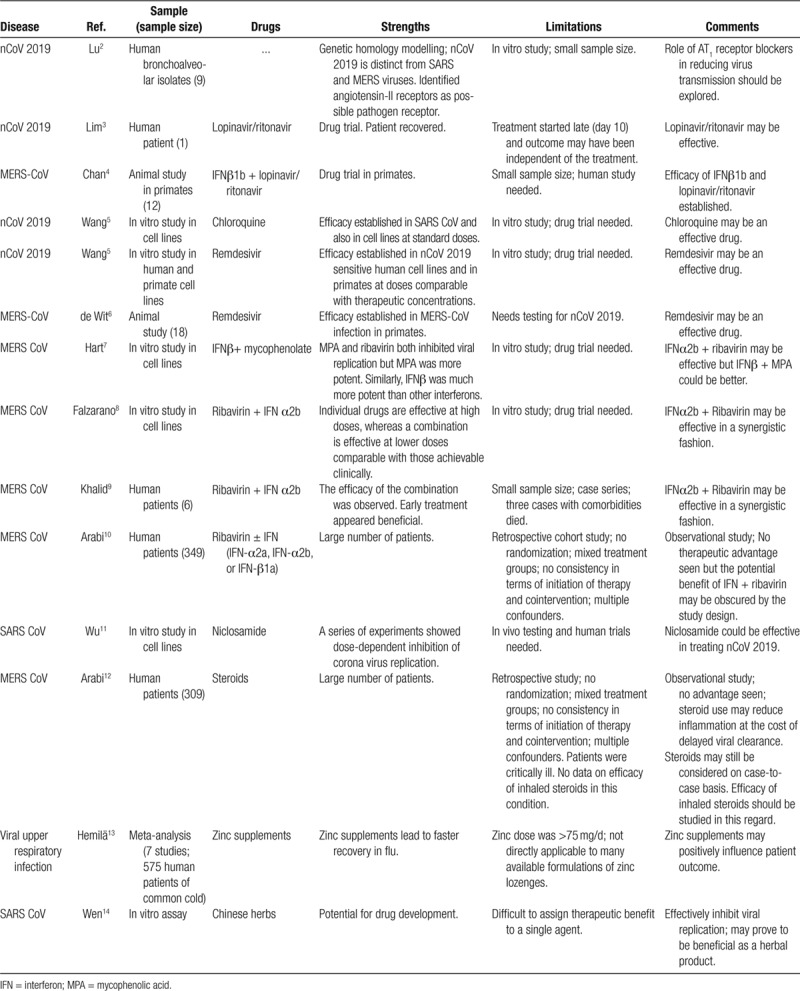The world came to know about a new corona virus infection spreading from Wuhan, China, in December 2019. Over the following 3 months, this respiratory pathogen, named as nCoV-2019, SARS CoV-2, or Covid-19, has affected many in the most populous regions of the world and there are growing concerns about it being a pandemic. World Health Organization (WHO) has reported infection in all continents in its Situation Report-42 published on 2 March 2020 and >3000 deaths (https://www.who.int/docs/default-source/coronaviruse/situation-reports/20200302-sitrep-42-covid-19.pdf?sfvrsn=224c1add_2). Although it causes a flu-like respiratory illness, the mortality is low among previously healthy, young individuals but high in elderly and critically ill.1 However, the low percent mortality has already transformed into a big absolute number (>3000 individuals) and counting. Each life is precious and there is a global movement to find treatment for this disease.
As yet, no definite prevention or cure is available for COVID-19. Lately, some reports have surfaced about various drugs indicated for other viral illness, being tried for this disease due to existing evidence in two related disorders, SARS-CoV and MERS-CoV. To critically evaluate the existing options, an attempt has been made to list the drugs considered potentially useful in corona virus infections including the previous outbreaks of SARS and MERS and are tabulated (Table 1) to derive lessons from the existing scientific literature.
Table 1.
Syndromes related to corona virus and their management

This is highly imperative that although new drug and vaccine development is in progress, existing treatment may be applied to save precious lives. The information in media that corona virus has no effective treatment has already created panic in the masses and resultant lock down in many parts of the world. Hence, it could be helpful to mitigate the impression of “no treatment” and resultant fear around the world.
Footnotes
Conflicts of interest: The authors declare that they have no conflicts of interest related to the subject matter or materials discussed in this article.
REFERENCES
- 1.Sun K, Chen J, Viboud C. Early epidemiological analysis of the coronavirus disease 2019 outbreak based on crowdsourced data: a population level observational study. Lancet Digital Health. 2020. 10.1016/S2589-7500(20)30026-1 [DOI] [PMC free article] [PubMed] [Google Scholar]
- 2.Lu R, Zhao X, Li J, Niu P, Yang B, Wu H, et al. Genomic characterisation and epidemiology of 2019 novel coronavirus: implications for virus origins and receptor binding. Lancet. 2020; 395:565–74 [DOI] [PMC free article] [PubMed] [Google Scholar]
- 3.Lim J, Jeon S, Shin HY, Kim MJ, Seong YM, Lee WJ, et al. Case of the index patient who caused tertiary transmission of COVID-19 infection in Korea: the application of lopinavir/ritonavir for the treatment of COVID-19 infected pneumonia monitored by quantitative RT-PCR. J Korean Med Sci. 2020; 35:e79. [DOI] [PMC free article] [PubMed] [Google Scholar]
- 4.Chan JF, Yao Y, Yeung ML, Deng W, Bao L, Jia L, et al. Treatment with lopinavir/ritonavir or interferon-β1b improves outcome of MERS-CoV infection in a nonhuman primate model of common marmoset. J Infect Dis. 2015; 212:1904–13 [DOI] [PMC free article] [PubMed] [Google Scholar]
- 5.Wang M, Cao R, Zhang L, Yang X, Liu J, Xu M, et al. Remdesivir and chloroquine effectively inhibit the recently emerged novel coronavirus (2019-nCoV) in vitro. Cell Res. 2020; 30:269–71 [DOI] [PMC free article] [PubMed] [Google Scholar]
- 6.de Wit E, Feldmann F, Cronin J, Jordan R, Okumura A, Thomas T, et al. Prophylactic and therapeutic remdesivir (GS-5734) treatment in the rhesus macaque model of MERS-CoV infection. Proc Natl Acad Sci USA. 2020; pii:201922083. [DOI] [PMC free article] [PubMed] [Google Scholar]
- 7.Hart BJ, Dyall J, Postnikova E, Zhou H, Kindrachuk J, Johnson RF, et al. Interferon-β and mycophenolic acid are potent inhibitors of Middle East respiratory syndrome coronavirus in cell-based assays. J Gen Virol. 2014; 95Pt 3571–7 [DOI] [PMC free article] [PubMed] [Google Scholar]
- 8.Falzarano D, de Wit E, Martellaro C, Callison J, Munster VJ, Feldmann H. Inhibition of novel β coronavirus replication by a combination of interferon-α2b and ribavirin. Sci Rep. 2013; 3:1686. [DOI] [PMC free article] [PubMed] [Google Scholar]
- 9.Khalid M, Khan B, Al Rabiah F, Alismaili R, Saleemi S, Rehan-Khaliq AM, et al. Middle Eastern respiratory syndrome corona virus (MERS CoV): case reports from a tertiary care hospital in Saudi Arabia. Ann Saudi Med. 2014; 34:396–400 [DOI] [PMC free article] [PubMed] [Google Scholar]
- 10.Arabi YM, Shalhoub S, Mandourah Y, Al-Hameed F, Al-Omari A, Al Qasim E, et al. Ribavirin and interferon therapy for critically Ill patients with Middle East respiratory syndrome: a multicenter observational study. Clin Infect Dis. 2019; pii:ciz544 doi: 10.1093/cid/ciz544. [DOI] [PMC free article] [PubMed] [Google Scholar]
- 11.Wu CJ, Jan JT, Chen CM, Hsieh HP, Hwang DR, Liu HW, et al. Inhibition of severe acute respiratory syndrome coronavirus replication by niclosamide. Antimicrob Agents Chemother. 2004; 48:2693–6 [DOI] [PMC free article] [PubMed] [Google Scholar]
- 12.Arabi YM, Mandourah Y, Al-Hameed F, Sindi AA, Almekhlafi GA, Hussein MA, et al. Corticosteroid therapy for critically Ill patients with Middle East respiratory syndrome. Am J Respir Crit Care Med. 2018; 197:757–67 [DOI] [PubMed] [Google Scholar]
- 13.Hemilä H. Zinc lozenges and the common cold: a meta-analysis comparing zinc acetate and zinc gluconate, and the role of zinc dosage. JRSM Open. 2017; 8:2054270417694291. [DOI] [PMC free article] [PubMed] [Google Scholar]
- 14.Wen CC, Shyur LF, Jan JT, Liang PH, Kuo CJ, Arulselvan P, et al. Traditional Chinese medicine herbal extracts of Cibotium barometz, Gentiana scabra, Dioscorea batatas, Cassia tora, and Taxillus chinensis inhibit SARS-CoV replication. J Tradit Complement Med. 2011; 1:41–50 [DOI] [PMC free article] [PubMed] [Google Scholar]


